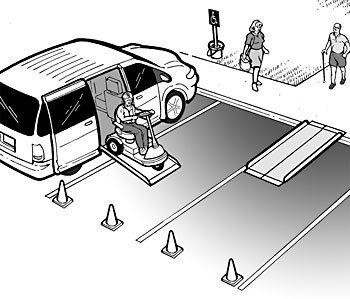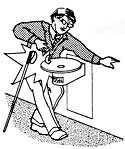ADA Problems Common at Voting Locations
November is normal voting season but early voting is already underway at the time of writing this post. Is your voting location accessible to handicapped individuals?
The following is presented by the US Department of Justice (DOJ). In communities large and small, people cast their ballots in a variety of facilities that temporarily serve as polling places, such as libraries, schools, and fire stations, or churches, stores, and other private buildings. Voters include people with a variety of disabilities, such as those who use wheelchairs, scooters, or other devices, those who have difficulty walking or using stairs, or those who are blind or have vision loss. They are people, young and old, who have come to their polling place to exercise their right to vote.
Many public entities report that their polling places are accessible. However, the Government Accountability Office estimates that only 27% of polling places were accessible to people with disabilities in the 2008 elections. This means that 73% of the polling places used in 2008 had architectural barriers that made it difficult or even impossible for people with disabilities to enter their polling place and vote side by side with their neighbors. That's discrimination. The five most common ADA problems at voting locations are discussed below.
Common Problems
Problem 1. Parking: Many polling places provide parking for voters but the provision of accessible parking is often overlooked. Parking areas may lack accessible parking spaces with adequate access aisles and signs, or may be on a sloped surface. Also, because other entrances – not the main entrance to the building – are commonly used as entry points to the polling place, especially at large facilities such as schools, permanent accessible parking may not be close to the entrance to the voting area. All of these barriers can prevent voters with disabilities from reaching the polling place.
Temporary accessible parking space marked with traffic cones and a temporary ramp provides access to the sidewalk
ADA Requirements: Parking provided at the polling place must meet specific minimum width requirements for spaces and access aisles so voters with mobility disabilities can get out of their car or van. Generally, the access aisle must be at least 60 inches wide for cars and 96 inches wide for vans. Van spaces can also have an access aisle at least 60 inches if the width of the van parking space is at least 132 inches. A sign, with the International Symbol of Accessibility, must mark each accessible parking space. Van-accessible spaces must be designated as such on the sign at these spaces. If only one accessible space is provided, it must be a van-accessible space. Accessible parking spaces must be in a level area with no steep slopes and on the shortest accessible route from parking to the accessible entrance to the polling place.
Temporary Solutions: Temporary parking must be located on the most level area available and as close to the accessible entrance as possible. Traffic cones (image above) and portable/temporary signs (photo below) can be used to create accessible parking spaces and access aisles.
Temporary sign providing direction to the area for van-accessible parking
Problem 2. Walkways in disrepair: If sidewalks and walkways are in disrepair, it can be difficult, and sometimes impossible, for a voter using a wheelchair or other mobility device to safely navigate to the polling place. Often, sidewalks and walkways are uneven, cracked, or contain potholes, gravel, dirt, or grass. Some sidewalks do not include curb ramps or, if they do, the ramped section is too narrow or steep.
A sidewalk with raised and broken sections is a barrier to access
ADA Requirements: Sidewalk or walkway surfaces must be at least 36 inches wide, without abrupt level changes (no level change greater than ½ inch), and the surface must be stable, firm, and slip resistant. Curb ramps should not be too steep (no steeper than 1:12).
Temporary Solutions: Temporary plates (no more than ½ inch thick) can be used to cover holes or cracks and provide a more level walkway. Ramps at least 36 inches wide, with a slope no more than 1:12, may be used to provide temporary access over curbs or onto sidewalks.
Temporary Ramp
Problem 3. Entrances: The entrance door area must be level and located on an accessible route into the voting area. The surface at the entry should not slope significantly in any one direction. Door openings that are too narrow may prevent a person with a wheel chair from entering the building. Limited maneuvering space for a person using a wheelchair to maneuver to open the door can also prevent a handicapped person from entering. Door hardware that is difficult to use or reach can prevent the handicapped from opening the door and a high door threshold can make it difficult for persons with wheel chairs or who have limited walking capabilities to enter. The door intended for use by the handicapped should be clearly marked with an appropriate sign.
Handicapped Individual Entering Temporary Voting Location
ADA Requirements: The entrance area must be level (no level change greater than ½ inch) and should not slope significantly in any one direction. All door openings must provide a minimum width of 32 inches and there must also be enough room for a person using a wheelchair to maneuver to open the door, including 18 inches of clear space beyond the latch side of the door. Additionally, the door hardware must not require tight grasping, pinching, or twisting, and the height of the door threshold must not be greater than ½ inch.
Temporary Solutions: The use of temporary ramps can provide access over steps or high thresholds. If the area in front of the door is not level or does not provide adequate maneuvering space, then the door may be propped open to allow the person using a wheelchair to enter the polling place. If one door of a double-leaf door is not wide enough, propping open the second door may provide enough clearance. In some circumstances, temporary levers or other adapters that do not require tight grasping, pinching, or twisting, may be installed over existing door hardware to provide independent access. Alternatively, a temporary doorbell or buzzer system may be used to alert a poll worker to open the door or doors for the voter.
Entry doors to the polling place can be
propped open or opened by staff to provide access
Or a temporary and portable ramp can be placed where the walkway meets a step. Temporary/portable ramps must meet the same criteria for slope and width as permanent ramps. See below.
A temporary ramp with handrails and edge
protection provides access over steps
Problem 4. Hallways: In many polling places, particularly those in large facilities such as schools and apartment buildings, hallways contain drinking fountains, coat racks, fire extinguishers, and other protruding objects. These objects may pose hazards to voters with vision disabilities, who may bump into them if they are not detectable by a sweep of a cane. See the diagram below.
Protruding Objects in Hallway
ADA Requirements: Wall-mounted objects located between 27 inches and 80 inches above the floor may not protrude or stick out from the wall more than 4 inches.
Temporary Solutions: Place traffic cones or other cane-detectable barriers, such as planters or portable railings, at or under protruding objects. Cane-detectable barriers can also be placed to re-direct voters with vision disabilities around or away from the protruding object. An alternate pedestrian route that does not include the protruding object, if available, may be appropriate.
A voter who is blind walks along a corridor with wall-mounted objects
that are not protruding objects because they do not protrude
more than 4 inches from the wall,
are mounted above 80 inches or are recessed into an alcove
Problem 5. Voting Areas and Booths: Voting often occurs in a small room or area within a building, with little space at the check-in tables and voting machines, making it difficult for voters with mobility disabilities to move through the voting area and cast their ballots. In winter months or during the rainy season, election officials may use cardboard, plastic floor coverings, tarps, or mats to cover the floor. These coverings can make it difficult to navigate and can easily become trip hazards for voters with disabilities and others.
ADA Requirements: There must be a minimum 36 inch wide route in and through the voting area. There also must be enough clear floor space in at least one voting station or booth to allow a voter using a wheelchair or other mobility device to approach, maneuver, and leave the voting station. Floor surfaces must be stable, firm, and slip resistant. Allowances must be made for service animals. See the diagram below.
Accessible Voting and Service Animal
Temporary Solutions: Arrange check-in tables and voting stations to provide an accessible path for the voter to go from the check-in table to the voting station and out again. At least one voting station should provide at least 30 x 48 inches of clear floor space to allow a voter using a wheelchair or other mobility device to maneuver. See the diagram below. All floor coverings, such as cardboard or plastic sheets, should be removed or firmly affixed to the floor to provide a stable and slip-resistant floor.
An accessible voting station with clear floor space
And an accessible route to enter, maneuver through the voting area to the accessible voting booth, and exit the voting area is required. See the diagram below for a representation.
Overhead view of the polling place showing
the accessible route and maneuvering spaces
for voters who use mobility devices













